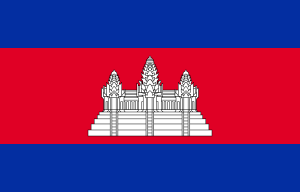Language/Central-khmer/Grammar/Yes/No-Questions
| ◀️ Basic Word Order — Previous Lesson | Next Lesson — Counting from 1 to 100 ▶️ |
In learning any new language, mastering how to ask questions can open up a world of communication and understanding. In Central Khmer, forming yes/no questions is one of the fundamental skills that will help you engage with native speakers and navigate daily conversations. In this lesson, we will explore the structure of yes/no questions in Central Khmer, focusing on the essential question particles, proper intonation, and various examples to solidify your understanding.
Through this lesson, you will learn:
- The basic structure of yes/no questions.
- The use of question particles.
- Intonation patterns in spoken Khmer.
- Practical examples and exercises to enhance your learning experience.
By the end of this lesson, you will confidently be able to form and ask yes/no questions in Central Khmer.
Understanding Yes/No Questions[edit | edit source]
Yes/no questions are questions that can be answered with a simple "yes" or "no." In Central Khmer, forming these questions is straightforward but requires understanding specific elements like word order and question particles.
Basic Structure[edit | edit source]
The basic structure of a yes/no question in Central Khmer typically follows the Subject-Verb-Object (SVO) order, similar to English. However, the inclusion of a question particle at the end transforms a statement into a question.
For example:
- Statement: អ្នកនិយាយភាសាខ្មែរ (You speak Khmer)
- Yes/No Question: អ្នកនិយាយភាសាខ្មែរទេ? (Do you speak Khmer?)
Notice how the addition of ទេ? changes the statement into a question.
Question Particles[edit | edit source]
In Central Khmer, the most commonly used question particles are ទេ? (te) and អត់? (at). Each serves a similar purpose but can convey slightly different nuances.
- ទេ? is used when expecting a "yes" or "no" response.
- អត់? is often used when the speaker is unsure and seeks confirmation.
Intonation in Yes/No Questions[edit | edit source]
Intonation plays a crucial role in asking questions in Central Khmer. Typically, the pitch of your voice will rise at the end of the question, similar to English. This rising intonation is a key indicator for listeners that you are asking a question rather than making a statement.
Examples of Yes/No Questions[edit | edit source]
To illustrate how to form yes/no questions in Central Khmer, let's look at some examples:
| Central Khmer | Pronunciation | English |
|---|---|---|
| អ្នកទិញម្ហូបទេ? | anek tynh mhoup te? | Do you buy food? |
| អ្នកទៅរៀនអត់? | anek tveu rian at? | Are you going to study? |
| អ្នកស្រលាញ់ខ្ញុំទេ? | anek sralanh khnhom te? | Do you love me? |
| គាត់មកពីសៀមរាបទេ? | kot mok pi Siem Reap te? | Is he from Siem Reap? |
| អ្នកចូលចិត្តកម្សាន្តទេ? | anek cholchet kamsant te? | Do you like to have fun? |
| អ្នករាំអត់? | anek ram at? | Are you dancing? |
| វាមានកម្ចីទេ? | vea mean kamsai te? | Is there a loan? |
| អ្នកធ្វើការនៅទីនេះទេ? | anek tveu kar nov ti nih te? | Do you work here? |
| កុមារនេះជាអ្នកជំនួយទេ? | kumar nih chea anek chumnuoy te? | Is this child a helper? |
| អ្នកចង់ទៅកន្លែងនោះទេ? | anek chang tveu kanlaeng noh te? | Do you want to go there? |
Practice Exercises[edit | edit source]
Now that you've grasped the fundamentals of yes/no questions in Central Khmer, it's time to put your knowledge to the test! Here are some practice exercises for you.
Exercise 1: Transform the Statements[edit | edit source]
Transform the following statements into yes/no questions:
1. អ្នកញ៉ាំបាយ (You eat rice)
2. គាត់ស្ដាប់ភ្លេង (He listens to music)
3. យើងចូលរួមក្នុងកម្មវិធី (We participate in the event)
Solutions:
1. អ្នកញ៉ាំបាយទេ? (Do you eat rice?)
2. គាត់ស្ដាប់ភ្លេងអត់? (Does he listen to music?)
3. យើងចូលរួមក្នុងកម្មវិធីទេ? (Do we participate in the event?)
Exercise 2: Choose the Correct Question Particle[edit | edit source]
Fill in the blanks with the appropriate question particle (ទេ? or អត់?):
1. អ្នកទៅសាលាម៉ូត? (Do you go to school ___?)
2. វាមានសត្វនៅផ្ទះ? (Is there a pet at home ___?)
3. អ្នកស្រលាញ់ក្មេងនោះ? (Do you love that child ___?)
Solutions:
1. អ្នកទៅសាលាម៉ូតទេ? (Do you go to school?)
2. វាមានសត្វនៅផ្ទះអត់? (Is there a pet at home?)
3. អ្នកស្រលាញ់ក្មេងនោះទេ? (Do you love that child?)
Exercise 3: Create Your Own Questions[edit | edit source]
Using the following verbs, create your own yes/no questions.
1. ទៅ (to go)
2. ធ្វើការ (to work)
3. ស្រលាញ់ (to love)
Solutions:
1. អ្នកទៅទេ? (Do you go?)
2. អ្នកធ្វើការទេ? (Do you work?)
3. អ្នកស្រលាញ់ខ្ញុំទេ? (Do you love me?)
Exercise 4: Listening and Intonation Practice[edit | edit source]
Record yourself reading the following questions aloud. Pay attention to your intonation and ensure that your pitch rises at the end.
1. អ្នកចូលចិត្តទស្សនាហង្សទេ? (Do you like to watch movies?)
2. អ្នកជួយខ្ញុំអត់? (Will you help me?)
3. គាត់មកពីកម្ពុជាទេ? (Is he from Cambodia?)
Solutions: Self-assessment based on recording.
Exercise 5: Response Practice[edit | edit source]
Respond to the following questions in Khmer, using "yes" or "no" (បាន / មិនបាន):
1. អ្នកចង់កាហ្វេអត់? (Do you want coffee?)
2. អ្នកចេះនិយាយភាសាអង់គ្លេសទេ? (Do you speak English?)
3. អ្នកត្រូវការជំនួយទេ? (Do you need help?)
Solutions:
1. បាន / មិនបាន (Yes / No)
2. បាន / មិនបាន (Yes / No)
3. បាន / មិនបាន (Yes / No)
Conclusion[edit | edit source]
Congratulations! You've made it through the lesson on forming yes/no questions in Central Khmer. This skill is essential for navigating conversations and building rapport with Khmer speakers. Remember to practice the intonation and make use of the question particles in your daily interactions. Keep exploring the world of Khmer language, and you’ll find that every question you ask brings you one step closer to fluency.
| ◀️ Basic Word Order — Previous Lesson | Next Lesson — Counting from 1 to 100 ▶️ |

